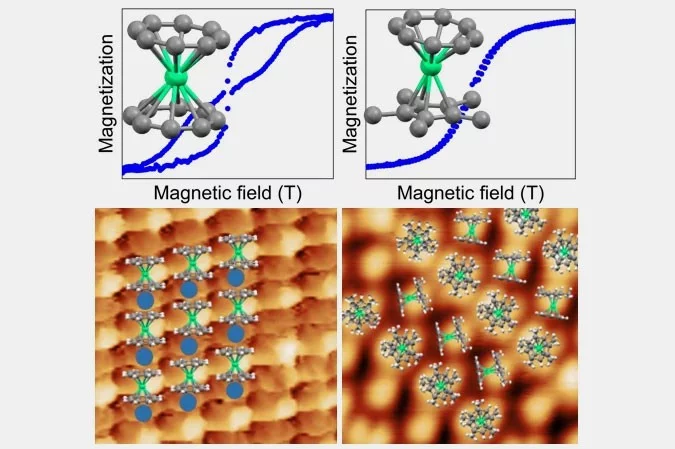Molecular single-ion magnets act as ultra-small magnets that can retain their magnetization. When organized on a well defined surface, they could allow storing information at more than hundred times higher storage densities than what is nowadays available.
In the present study performed at the Swiss Light Source an international research team investigated monolayers of two very similar types of erbium-based single-ion magnets including molecular carbon-based 5-rings (cyclopentadiene) and 8-rings (cyclooctatetraene). Surprisingly, X-ray magnetic circular dichroism experiments at temperatures down to 3 K revealed that they behave very differently when adsorbed on a flat silver surface. In one case, the magnetic hysteresis loop is essentially closed indicating a weak capacity of retaining stored information. In the other case a clear magnetic hysteresis opening exists.
The X-ray experiments conducted at the X-Treme and PEARL beam lines of the SLS, supported by scanning probe microscopy, show that the vastly different magnetic behavior is indirectly related to the different orientation and adsorption configuration of the molecular single-ion magnets on the surface: While the single-ion magnets containing two 8-rings lie down on the surface with their symmetry axes parallel to the surface plane, the mixed compound containing an 8-ring and a 5-ring exhibits a complex, mixed standing-up and lying-down geometry. Because the organic rings have pi-orbitals that interact with the metal, when the rings are parallel to the surface, the mixed 8-ring/5-ring single-ion magnet exhibits a stronger interaction with the metal compared to the pure 8-ring single-ion magnet. The strong molecule-surface interaction is known to destroy the magnetic hysteresis of single-ion magnets, hence adsorption in the lying-down geometry lowers the molecule-surface interaction and preserves the magnetic hysteresis.
Contact
Dr. Jan Dreiser
PSI, Photon Science Division
Forschungsstrasse 111, 5232 Villigen PSI, Switzerland
Telephone: +41 56 310 5895
E-mail: jan.dreiser@psi.ch
Prof. Dr. Frithjof Nolting
PSI, Photon Science Division
Forschungsstrasse 111, 5232 Villigen PSI, Switzerland
Telephone: +41 56 310 5111
Email: frithjof.nolting@psi.ch
Original Publication
Orientation-Driven Large Magnetic Hysteresis of Er(III) Cyclooctatetraenide-Based Single-Ion Magnets Adsorbed on Ag(100)
Vladyslav Romankov, Moritz Bernhardt, Martin Heinrich, Diana Vaclavkova, Katie Harriman, Niéli Daffé, Bernard Delley, Maciej Damian Korzyński, Matthias Muntwiler, Christophe Copéret, Muralee Murugesu, Frithjof Nolting, Jan Dreiser
Small Science (2024), https://doi.org/10.1002/smsc.202400115 (link is external)

